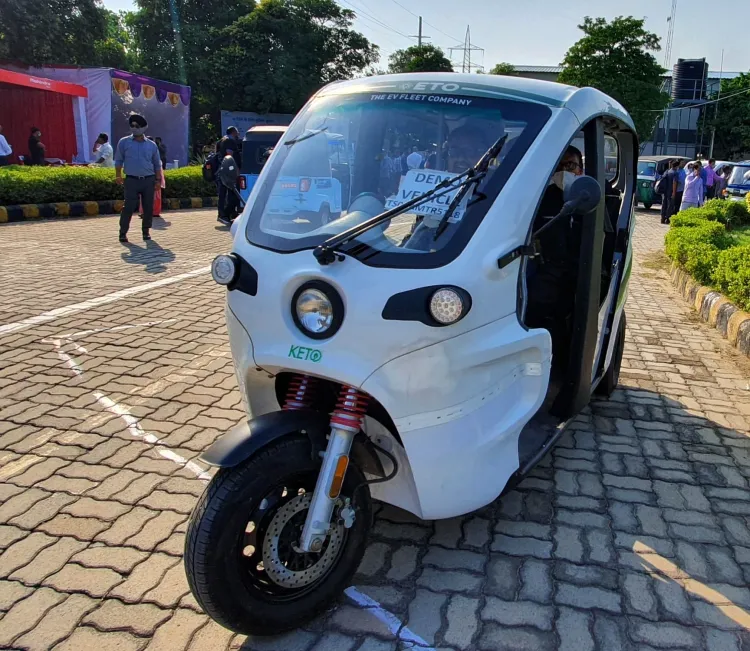Is India the largest market for electric 3-wheelers, surpassing China?

Synopsis
Key Takeaways
- India leads globally in electric three-wheeler sales.
- 20% growth in sales reached 700,000 vehicles in 2024.
- The PM E-DRIVE scheme supports electric vehicle adoption.
- China's electrification of 3-wheelers has stagnated.
- Electric 2-wheeler market shows strong growth.
New Delhi, May 18 (NationPress) India has been recognized as the largest global market for electric three-wheelers, surpassing China, for the second consecutive year, with a remarkable 20% increase in sales resulting in 700,000 vehicles in 2024, as detailed in a report by the International Energy Agency (IEA).
The IEA’s Global EV Outlook 2025 report emphasizes that the three-wheeler sector is significantly dominated by both China and India, which represent over 90% of the sales for both electric and conventional three-wheelers.
According to the report, "The electrification of three-wheelers in China has stagnated below 15% for the last three years. In 2023, India surpassed China to emerge as the world's largest market for electric three-wheelers, and this trend continued into 2024, with sales nearing 700,000 vehicles, marking close to a 20% year-on-year growth."
This upward trajectory is expected to persist, bolstered by government initiatives under the new PM E-DRIVE scheme, which facilitated the deployment of over 300,000 electric three-wheelers for commercial use in 2024.
The report further highlights that China, India, and Southeast Asia are the leading markets for two- and three-wheelers, collectively accounting for approximately 80% of global sales in 2024, with these vehicles serving as the primary means of private passenger transportation in these regions.
India's vibrant electric two-wheeler market saw an increase in the number of original equipment manufacturers (OEMs) from 180 in 2023 to 220 in 2024. However, the top four players dominated, capturing 80% of the 1.3 million electric two-wheelers sold in the country in 2024, representing 6% of the overall two-wheeler market.
Although the initial purchase cost of electric two-wheelers remains higher than their conventional counterparts, intensifying competition is driving OEMs to provide more affordable electric options.
"Supportive policies are also aiding in narrowing the price difference between electric and internal combustion engine two-wheelers, with the PM Electric Drive Revolution in Innovative Vehicle Enhancement (PM E-DRIVE) policy continuing the financial assistance previously provided under the Faster Adoption and Manufacturing of Electric Vehicles (FAME)-II and Electric Mobility Promotion Scheme initiatives," states the IEA report.
The PM E-DRIVE scheme is set to run until March 2026, aiming to facilitate the rollout of around 2.5 million electric two-wheelers, an increase from the 1 million target under the prior FAME-II policy.
On the production side, the 80 largest electric two-wheeler manufacturers in India had a combined production capacity of 10 million electric two-wheelers in 2024, which is nearly eight times the domestic sales for that year. This capacity is projected to rise to 17 million electric two-wheelers shortly, provided all OEM announcements are realized.
The IEA report also notes that the total electric car sales in India saw a modest 2% increase, totaling approximately 100,000 units in 2024. Sales in India experienced a 45% year-on-year growth, approaching 35,000 electric car sales in the first quarter of 2025.
In India, high import tariffs on electric vehicles and the availability of locally manufactured, affordable electric models kept the share of Chinese imports in India's EV sales below 15% in 2024.
While the lowest-priced battery electric car model was produced locally by a Chinese OEM (the MG Comet EV, priced under $8,000), the average cost of imported Chinese battery electric vehicles (BEVs) was double that of domestically produced models, according to the report.
In 2024, all battery electric vehicle models manufactured by Indian automakers were priced below $20,000, while none of the imported Chinese BEV models were available for under that price point.
Overall, the average price disparity between battery electric and internal combustion engine vehicles decreased to below 15% for small cars and 25% for SUVs in 2024.
The IEA also highlighted India's rapid advancement in electric bus deployment since 2020, with the number of electric buses soaring nearly fourfold from under 3,000 to over 11,500 by the end of 2024.









